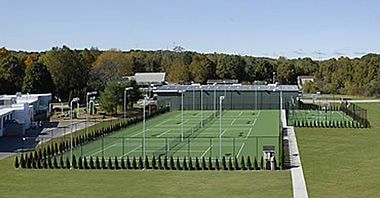Arias Tennis Wizard Six
Warm Up, Stretch and Flexibility - The Debate: Part II
 |
In our initial discussion on "Warm Up, Stretch and Flexibility - The Debate," we reviewed and discussed the basic issues of the problem. Specifically, while warm up is important before play and exercise in general, current research argues that:
- greater static flexibility does not always decrease the risk of muscular injury;
- flexibility and stretching may be unrelated to injury risk;
- stretching has minimal effect of the stiffness of muscle, decreases muscular performance, and modifies the energy recovery of stretched muscle.
Due to the subtleties in some of the meanings of the words "stretching," "warm up," and "flexibility" we reviewed the definitions.
Bottom line: Warm up is important and beneficial; however stretching within the warm up does not furnish the presumed benefits of injury reduction and enhanced muscle performance.
What does stretching do and what are its benefits? What happens to your body when you stretch?
The training (long-term) effects of stretching are beneficial to static flexibility and to performance. Stretching can increase range of motion (static flexibility). Knudson [1] reported stretching increases of 5-20% in static flexibility, although the effects require several weeks to obtain and are short-lived (you need to stick with it or you lose what you have gained).
Short-term increase in static flexibility appears to be largely related to the person's tolerance to the discomfort of a stretching position, not major changes in the material properties of the muscle/tendon. Another caveat to this is that passive stretching (using an external force - often a person) can cause a large amount of tension on the muscle (extension). Vigorous, forceful stretching can weaken and injure muscles by stretching ligaments or creating unsafe loads.
Normal static flexibility refers to "typical" limits in the joint movement between the extreme positions (i.e., range of motion). Those with low or a loss of range of motion (inflexible, anklyosis) and those with an inordinately high range of motion (hypermobile) also have higher injury rates [1]. In the case of those with an extreme range of motion, the cause may be that greater range of motion and less tissue resistance causes a greater instability in the joint.
A growing number of studies have documented decreased muscular performance after stretching. As with other forms of training, stretching temporary weakens the body, prior to the body recovery and it counteracting those effects. Researchers conducting maximum strength tests, running and jumping studies have observed muscle performance reductions of 4-30%. The cause appears to be neuromuscular inhibition (reduced ability to activate the muscle and speed of nerve impulse) and decreased muscle contraction force. Fowles and colleagues [2] observed this to last up to an hour. A recent article by Groner [3] states this could be up to 24 hours.
Another important point to remember is that flexibility is not an overall body characteristic, but is dependant on the specific joint and direction of motion. A person can have normal static flexibility in one part of their body and be inflexible or hypermobile in another. Gender (women typically have more static flexibility than men) and body shape and size affect static flexibility. People can lose static flexibility due to lack of physical activity, or from work or sport related repetitive motions as in the overarm motions in baseball throwing and some tennis strokes. Continual usage of high heels may cause a decrease in ankle flexibility.
While data is available on normal ranges of motion for most joints, it is not known whether there is an "optimal" level of static flexibility for different joints or the entire body. More research is needed to determine this and correlate it with injury reduction.
Using newer methods of measuring flexibility, scientists record "dynamic flexibility" or muscle stiffness, which refers to how quickly the tissue resistance rises in a stretch. Knudson has noted the following, "... stretching does not create a short-term decrease muscle stiffness" and "... several studies have also shown that stretch training over time does not decrease muscle stiffness." While you may feel lower passive tension in the a particular muscle group/joint, this is not an indicator of the mechanical stiffness of a tissue.
However, there are benefits to stretching as pointed out and experts are suggesting that stretching usually or normally be done in your cool-down phase and avoided in warm-up for athletic competition. Knudson [1] notes, "Stretches should slowly elongate and hold muscles with low levels of force for 15 to 30 seconds. Four to five stretches per muscle group or area of the body are usually recommended." Only individuals who need great amounts of flexibility, like gymnasts and dancers, or have severe flexibility limitations would engage in stretching at the end of a warm-up.
Quoting Knudson, "Given that the lowest injury rates seem to correspond to normal flexibility and higher injury rates with the extremes in flexibility (inflexible and hypermobile), maintenance of normal or moderate amounts of static flexibility should be the goal for most people. ... Most athletes with normal flexibility should perform their stretching routines after practice or competition."
Many thanks to Dr. Duane Knudson for his assistance with this column.
Until Next Month ... Jani
References
1. Knudson, D. (in press). Warm-up and flexibility. In: Chandler, J. & Brown, L. (Eds.). Introduction to Strength and Conditioning. Baltimore: Lippincott Williams & Wilkins.
2. Fowles JR, Sale DG, MacDougall JD. (2000) Reduced strength after passive stretch of the human plantar flexors. Journal of Applied Physiology; 89:1179-1188.
3. Groner, C., (October 2004) "Stretching II Out", BioMechanics
Online: www.biomech.com, CMP Healthcare Media.
You can find more articles like this to help your tennis game by going to www.tennisserver.com .
Send your questions to the
< Previous | Return To Wizard Home | Next >
Programs

The SCJTL Summer Tennis League an inclusive “playing” experience for all junior tennis participants. Since 1997 the SCJTL Summer Tennis League has offered all participants the opportunity to play on teams on a league that emphasizes fun, fitness and friends.
Tennis Lessons
![]() Joe Arias is available for a full range of tennis lessons and personal coaching services. Private and group lessons for all ages and levels. Specialist in tennis biomechanics corrections and improvements, game style enhancement, singles and oubles training .
Joe Arias is available for a full range of tennis lessons and personal coaching services. Private and group lessons for all ages and levels. Specialist in tennis biomechanics corrections and improvements, game style enhancement, singles and oubles training .
Find Out More About Tennis Lessons
SCJTL Training Centers

The SCJTL Training Centers are learning and skill development facilities. Kids and adults learn and improve tennis skills thru SCJTL Personal Coaching Services and SCJT Player Development programs.
Find Out More About SCJTL Training Center
SCTEF
 Suffolk County Tennis and Education Foundation, Inc. (SCTEF) is a New York State, non profit corporation and Federal 501(c)(3) created in 2003, with the purpose of providing athletic, educational and charitable activities to all Suffolk County residents regardless of age, ability or socio-economic status.
Suffolk County Tennis and Education Foundation, Inc. (SCTEF) is a New York State, non profit corporation and Federal 501(c)(3) created in 2003, with the purpose of providing athletic, educational and charitable activities to all Suffolk County residents regardless of age, ability or socio-economic status.

